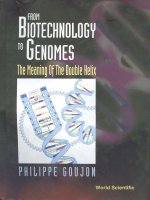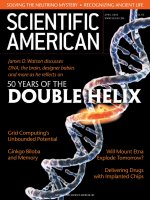from biotechnology to genomes the meaning of the double helix - philippe goujon
Bạn đang xem bản rút gọn của tài liệu. Xem và tải ngay bản đầy đủ của tài liệu tại đây (45.55 MB, 806 trang )
FROM
BIOTECHNO~OGY
To
GENOME$
The Meanin
j
Oi
The Double
Hdk
The
Meaning
Oi
The
Double
~
PHlLlPPE
GOUJON
Universite'
Catholique
de
lille
France
World
Scientific
Singapore. New Jersey. London Hong Kong
hrhlished
by
\&
orld Scientific Publishing
C
o
Pte
Ltd
P
OBox 128.Fanei
Road.
Singqnre912805
LTS
1
ofice
Suite
IB,
l060Maiii Street. Riverbdge
NJ
07661
UK
ofice
57
Shelton
Street, Lovent (Jarden, London
WCW
9IIE
British Library Cataloguing-in-Publication Data
A
catalogue record for this book is available from the British Library.
FROM
BIOTECHNOLOGY
TO
GENOMES
The Meaning of
the
Double IIelix
Copyright0 2001 bj7 World Scicntific Publishing Co
Ptc
Ltd
111
righfc
recenurl.
Thic hook,
orpartc
thereoj
may
rtof
he
reproduced
in
anyform
or hy
any
rizeaitc,
dectronic
or
nzecltuttical,
iltcli~dingplzotocopyin~, rrcordittg
or
MY
ittfortnutiort
storage
uttd
retrieval
~ptent tiow krtonvt
or
to
be
inecrtterl,
without
u~ri~etiperwi~~iott front
the
Pablidter.
For photocopying
of
niatcrial in this volunic, plcasc pay a copying
fcc
through
Ihc
Copyright
Clearance Center, Inc 222 Rosewood Drive, Danvers,
MA
01923,
USA.
In this case permission to
photocopy is
not
required
froiii
the
publisher.
ISBN
98
1-02-4328-6
Printed
in
Singapore
by
Mainland Press
Foreword
At the time of writing this foreword (June
1998),
the genome of
15
unicellular
species have been completely sequenced and made available to the scientific
community: ten
Eubacteria,
four
Archaebacteria
and yeast, thc only
eucaryotic cell
so
far.
During the last three years, the amino acid sequences from over
35,000
proteins uiicoded by these genomes have been deciphered. More than
10,OOO
proteins thus unveiled have an unknown fLinction and are members of new
protein families yet to
be
identified. The sequence of each new bactcrial
genome (with the possible exception of
E.
coli)
provides the microbiologist
with a huge amount
of
fi-esh metabolic infomation, far
in
excess
of
that
already
in
existence.
A
surprisingly large biochemical diversity in the bacterial
world has been revealed. If over a million bacterial species exist, of which
only approximately
3,000
have
so
far been cultured, then the enormous task
of identifying the bacterial world through the sequencing of its geiiomes is
still to be accomplished. Dozens of sequencing centers (rapidly expanding
to become hundreds in number) all over the world are undertaking this task,
which will result
in
the discovery of thousands
of
new proteins. These
figures do, however, call into question the exploitation of this data.
Each one
of
these bacterial genonies forins a tier of biotechnological
information, the exploitation of which will create new catalysts, hopefiilly
inore efficient and more specific, but less detrimental to the environment
than most of the chemical processes currently in use. When the plant and
animal kingdoms have been fully exploited by the human race, the
domestication of a still largely-unexplored and immense world will remain
-
that of the
Eubacterial
and
Archebacterial
kingdoms.
V
vi
From
Biofechnology
to
Genomes:A Meaning
for
the Double Helix
In the next few years, a considerable portion
of
the sequencing of bacterial
genomes could be performed in developing countries, where labor costs are
low. It is, however, to be expected that the industrial exploitation of this
newly available knowledge will continue to be carried out primarily by large
multinational corporations. Whatever the outcome, the race for the
identification and exploitation of new microbial enzymes is on; we can only
hope that,
in$ne,
it will be beneficial to mankind as well as to the preservation
of other living species. Equally important as the production of new industrial
enzymes, newly acquired panoramic knowledge of pathogenic microbial
genonies will considerably speed up the development of new vaccines and
antibiotics.
In addition to harnessing of the bacterial world, it is easy to imagine the
quantitative and qualitative increases in plant productivity which will result
fi-om the complete knowledge of the genomes of some one hundred plant
species, which currently constitute the core of our food source. Moreover,
it is possible to predict the elimination of the potent parasites currently
responsible for the untimely deaths of millions of people each year by
thoroughly understanding of their metabolism. This knowledge will not be
complete until their genomes have been sequenced.
Sa,
what will the repercussions
on
the medical world would be, that will
be brought about by knowing the sequence of all the proteins constituting
over
200
cell types which make up the human body? All the large
pharmaceutical coinpanies
are
investing heavily
in
medical genomics, from
which they are hoping to create new drugs, new diagnostic tools and new
genetic treatments. The extent of these investments is somewhat surprising,
as mentioned by Philippe Goujon in his book, since the financial return
appears risky and, at best, will only be obtainable in the long term. I mi,
nevertheless, convinced that the reading of the human genome is a necessary
(though not,
of
course, the only) step
in
the molecular biology of all essential
human biological functions, which sooner or later will be used to the benefit
of medical knowledge and ultimately mankind.
This optimism isjustified by my belief
in
the intrinsic value of scientific
knowledge and by the extraordinary progress in molecular genetics in the
past
25
years. It has flourished
from
the first genetic transformation of
Foreword
vii
bacteria to the first complete sequence of microbial genomes, including
yeast, and will lead to the complete sequence of the human genome, hopefiilly,
by the year 2005.
In the following pages, the science historian Philippe Goujon describes,
in detail, the action talcen by the European Commission in the domain of
biotechnology. He has compiled a comprehensive amount of documentation
and has dug deep into the archives and the ineinories
of
pioneers such as
Fernand
Van Hoeck, Dreux de Nettancourt, Etienne Magnien, Ati Vassarotti
and Mark
F.
Cantley, who were (or are still) key players
in
the birth and
development of biotechnology programs at the European Commission.
Philippe Goujon has placed this European effort in a scientific, sociological
and industrial context going back to the beginning of the 20th Century.
Although the European effort has become much more prolific than initially
predicted, Philippe Goujon highlights the still dominant contributions of the
United States of America and multinational corporations to the massive
industrial exploitation of molecular biotechnology which, after a first
half-
century of progressive iinplementation, will undoubtedly triumph during the
21st
Century. Philippe Goujon, an informed observer, incticulously describes
the succession of scientific discoveries which have resulted
in
the recent
discovery of the complete sequence of genomes. Finally, as a scientific
philosopher, he makes his position clear on the future of genomics and its
possible implications.
He
also gives a concluding analysis of the role of
science
in
our society.
This coinprchcnsivc analysis, based on remarkable documentation, is a
massive and unique undertaking.
I
am pleased to have been able to foster
the writing of a book which,
I
believe, will become a classic in the
contemporary History of Science.
Professor
Andrk
Goffeau
UniversitC
catholique dc Louvain
Unit6 dc Biochimie Pysiologiquc
2,
Place Croix du Sud
1348
Louvain-la-Neuve
Belgium
Contents
Foreword
Introduction: The Essence of Life and the Labyrinth of
the Genome
1
The Invention of Biotechnology
1.1
The Origins
of
Biotechnology
1.2 The Emergence of
a
New Concept of Life
1.3
From Zymotechnology to Biotechnology
1.4 The Engineering of Nature -Towards thc Best
of
all
1.5
Technique, Biology and the Development of Biotechnics
1.6 The Recognition of Biotechnology by the Institutions
Possible Worlds
2
Political Interpretations of Biotechnology and the Birth of
the First Research Programs
2.1 The Example
of
the United States
2.2 Biotechnology in Japan: Economic Success and
Ecological Failure
2.3 Germany and the Political Aspect of Biotcchnology
2.4
The British Development of Biotechnology
:
Delayed
Political Reaction
2.5 Thc French Reaction
2.6 The European Community and Biotechnology -The
Emergence
of
the First European Biotechnology Programs
Xlll
1
5
11
13
21
23
43
62
64
73
78
84
90
92
ix
x
From Biotechnologyto Genomes:A Meaning
for
the Double Helix
3
The Foundations
of
the Heralded Revolution
3.1 From the Frontiers of Genetics to the Birth
of
Molecular Biology
3.2 The Secret
of
Life:
DNA
3.3 The First sequencing
of
a Protein: Insulin
3.4 Techniques
of
DNA Sequencing
3.5 Gene Money, or the Miracles Expected
of
Biotechnology
3.6 The Japanese Threat and the Human Frontier
Science Program
4
Attack on the Genomes: The First Genetic and Physical Maps
4.1 The Problem
of
Gene Localization
4.2 Polymorphic Markers, Gene Mapping and the
Great Gene Hunt
4.3 Towards a Complete Linkage Map
4.4 Physical Genome Mapping: The Reconstruction of
a
Complicatedhzzle
4.5 The First Physical Maps
of
Large Genonies
4.6 Towards a Physical
Map
of
the Human Genome
5
The
Human Genome Project and the Interiiational
Sequencing Prograins
5.1 The Ultimate Challenge: The Human Genome Project
5.2 The Department
of
Energy Initiative
5.3 The NIH Genome Project
5.4
HUGO,
or the Difficulties of International Coordination
5.5
The Iniportance
of
Model Organisms
5.6 The International Dimensions of Genome Research:
The First Stirrings
in
other Countries
6
European Bioteclinology Stratcgy and Sequencing
the Yeast Genome
6.1 Towards a New European Research Policy for
Biotcchnology
116
116
126
135
139
161
174
182
182
185
194
202
205
215
217
218
230
245
252
267
273
327
328
Contents
xi
6.2
The
1980s:
An
Implenientationof the
1983
Strategy?
6.3
3AP’s
First Year
6.4
The Revision of the
BAP
Program
6.5
The Origins andNature
of
the Yeast Genome
6.6
Critical Discussions and the Adoption of the Yeast
Sequencing Project
Genome Sequencing Project
7
The Decryption of Life
7.1
The Structure and Organization of the European
Yeast Genome Sequencing Network
7.2
A World First -The Sequence for
a
Whole Eucaryote
Chromosome: Chromosome111
of
the Yeast
Succhuro~~iyc~es
cerevisiue
7.3
The Complete Sequence
of
the Genome and the
Intensification
of
European Efforts
7.4
After the Sequence -The Challenge of Functional
Analysis
7.5
Sequences, Sequences and More Sequences
7.6
From Science to Economics
8
Conclusion: The Dreams
of
Reason or the New Biology’s
Dangerous Liaisons
8.1
Fascination but Anxiety Concerning Progress in the
Life Sciences
8.2
Reductionism
vis-u-vis
the Complexity
of
Life
8.3
Froni Science to Ideology -The Dangers
of
“The Genetic All”
8.4
The Health Excuse -A New Utopia?
8.5
Behind Gene Therapy
-
The Dangerous Liaisons
of the New Biology
8.6
Convenient Reductionism
8.7
The Reasons Behind
an
Ideology
34
1
353
359
369
382
42
1
421
434
45
1
487
511
606
643
643
648
658
666
676
683
684
xii
From
Biotechnology
to
Genomesr
A
Meaningforthe Double Helix
EPILOGUE
Dreams or Nightmares? Man Reasoned
out
by
His
Genes
Bibliography
Acronyms
Auhr Iridex
Subject Index
690
690
693
75
1
755
773
Introduction:
The
Essence
of
Life and
the Labyrinth of the Genome
During this century, all scientific domains have been marlied by important
discoveries, often made by extraordinary researchers and by a dynamism
which can truly bc considercd a pcnnancnt revolution. Sincc
1900,
scicntists
and their ideas have brought changes
su
swecping in their scopc that thcy
have modified our pcrccptions of the naturc of the universe. The first of
these changcs was in physics, with biology hot on its hecls. The rcvolution
in
physics started in the beginning of the 20th Century with the theories of
quantum mechanics and relativity. It was concerned with thc inside of thc
atom and the structure
of
space-time, continuing well into the
1930s
and
throughout the development of quantum mechanics. Most of what has
happened
in
physics, at least until recently, has been the result of those three
decades
of
work. With the Manhattan Project, physics was restructured at
the deepest level.
A
new form of research called "Big Science" had been
invented.
In
biology, the modern revolution began
in
the mid-1930s. Its initial
phase, molecular biology, reached a plateau of maturity in the
1970s.
A
coherent,
if
preliminary, sketch of the nature of life was set up during these
decades, in which a mastery of the mechanisms of life was increasingly
sought after, particularly for industrial use. There would be a second phase
to
the biological revolution, that of genetic engineering and genome research.
The consequence of this contemporary revolution was the advent
of
a
new
form of research
in
biology. It is the harbinger
of
the eminent role that
xiii
xiv
From
Biotechnology
to
Genomes:
A
Meaning
for
the Double Helix
biology will have
in
the evolution of society, and the effect this will have
on
our
way of life and thinking.
Several decades after physics, biology has also become “Big Science”
with the genome projects and is undergoing a revolution of a structural,
methodological, technological and scientific nature. Less than half a century
after the 1953 discovery of the structure of deoxyribonucleic acid (DNA) by
James Watson and Francis Crick, the great dream of decoding the entire
sequence of the genome of
an
organisiii became a reality. After viruses and
other “simple” organisms, scientists were starting to work on the genoines
of “c oniplex” organisms
.
In 1989, the United States initiated the Human Genome Prqject and
several nations, includmg Japan, became involved in genome research, setting
up large biotechnology and sequencing programs. At the same time, the
biotechnology programs funded by the European Economic Community
(the European Union) provided support for a consortium of European
laboratories to sequence the genome
of
the yeast
Succuromyces
cerevisiae.
Consequently
in
1992, for the first time, an entire eucaryote chromosome,
in
the form of chroniosome
I11
of the aforementioned baker’s yeast, was
sequenced. In addition, the European consortium and its international
collaborators managed in 1996 to break another record and obtain the entire
sequence for the yeast genome, some
14
million base pairs. During this gene
race, Europe managed to maintain its position as a leader
in
world genome
research and provided the international scientific community with a tool
whose usefiilness, especially for our understanding of the human genome,
becomes increasingly clear.
Scientific and industrial conipetition continues. The number
of
organisms
for which the entire genome sequence has been read is increasing. Along
with the yeast genome and smaller genoines that are nevertheless of biological
or economic importance, we expect a forthcoming completion of the
sequencing of the
100
million base pair genome of the nematode
Cuenorhabditis
elegans.
The first pilot programs for systematic sequencing
of the human genome’s three billion base pairs have been conipleted, making
way for larger sequencing projects of whole human chromosomes.
Introduction
xv
A
technological, scientific and economic revolution is under way, a
revolution whose effects are already being felt and which will shake the
fields of human and animal health, the pharniaceutical business, the
agro-
food industry, our environment and society as a whole.
As
announced by the
scientists and publicized
by
the mass media, the prowess of the new
biotechnology, the cloning of genes and even of entire animals (sheep and
monkeys) as well as the prophecies of several great scientist pundits bring
out fascination and concern within
us.
Science also produces pcrplexity.
Despite the importance of this new biology, of genome research and of
the aura thai surrounds them, it seems as if the general public is somewhat
in the dark as to the real issues, progress, possibilities and risks. The history
of these achievements is often misunderstood, even by some of the people
involved in them. In view of the ongoing revolution and its consequences,
whether scientific, political, economic, social or ethical, and the public’s
general misunderstanding of them, there was need for a
book
presenting the
origins and the history of genome research, its current status and its future.
This book hopes to
fill
that need.
At the source of this
book
there is a wonder, a passion, but also the
chance meetings that led me to write it. The wonder is that of the philosophy
of science and the window it provides on our world and its secrets, Man and
his
place in the universe. The passion is that of understanding science
as
it
evolves, the challengcs that hunian intclligencc
seeks
and thc risks linked to
the discoveries and revelations of this increasingly powerful field of
biotechnology.
I
first thought of writing this
book
during my post-doctoral
period between 1993 and 1996 at the
Universit6
catholique de Lowain. It
was during this time that
I
was fortunate enough to meet Professor Andre
Goffeau who
was
then coordinating the European yeast genome sequencing
project. During many conversations he opened up his archives and his
laboratory to me, as well showing me the fascinating and multidisciplinary
field of genome research, which lies at the frontier between fundamental
and applied science, and where technology and biology, research and indushy,
economy, politics, law and science all meet.
xvi
From
Biotecbnobgy
to
Genornes:
A
Meaning
for
the Double Helix
Fascinated by the work under way and carried
by
my enthusiasm for the
research despite the obstacles and difficulties involved in this endeavor,
naturally
I
was taken by the idea of a book on the European and world effort
to sequence the genome of
Saccharornyces
cerevisiae,
but also on genome
research
as
a whole, its origins and developments.
I
was immediately
supported by Professor Goffcau who, pronipted by some of his colleagues,
was looking for someone to write the “little tale” of the European and world
effort to sequence the yeast genome. As I browsed through the archives, I
became inore and more convinced that the origins, the size, and the
consequences of the changes
in
biology and society in general, wrought by
the initiators and maiiagers of the genome project, had to be communicated
to the world at large.
Academic work always uses
a
strict method of approach. This means an
ordered process of disciplined progress. Like any study this work needed a
perspective,
an
approach. But because it is
a
story,
a
rational approach
would have been limiting and unsatisfictory, which accounts for the anecdotes
included in this work. Ideas are often born of happy coincidences, during
a
conversation, while reading
an
article or meeting someone, or during
a
conference, and most often if not always in a propitious scientific, economic
and sociological context. They generally begin
as
an
attractive hypothesis.
If
the idea is stimulating enough, work begins in a new field or domain. It’s
oRen not a linear process. Various eddies influence the flow of scientific
construction
as
it is taken away from the official paths and then often sccms,
to use a term from physics, chaotic aiid subject to sudden changes of direction.
But that means surprise, and surprise is what researchers live for and from.
Besides contributing to an understanding of modern biology and
biotechnology, this work also hopes to serve to explain scientific practice,
its means, its rules, and its presence amongst us,
in
our individual and
collective lives. In particular, it seeks to underline, through the history of
biotechnology and the genesis and development of genome research, the
deep relationship that links these domains, while stressing that they face not
only the material world but society as a whole. Biotechnology and genome
research goes beyond the purely operational perspective to embed itself
resolutely
in
human history,
in
coniinunication, negotiation and cornniunal
creation.
introduction
xvii
This work shows that the bases of biotechnology and the genome projects
lie within historic projects
in
their own particular political, socio-cultural
and economic context. It also demonstrates through its investigation of the
history of this ongoing biological and particularly biotechnological and
genome research revolution, the human aspect of science and the creativity
which is inherent to it. It attempts to, through its philosophical and ethical
reflections, clarify the manner
in
which they are products of society
as
well
as an influence upon it.
To trace the story of biotechnology and the genome programs, in particular
that of the yeast genome, one has to take into account the various groups
affected, watch the development and change of their various scientifico-
socio-economic aspects
in
reaction to conceptual and technical modifications
and the rapprochciiient of previously quite separate disciplines. One single
method would therefore not allow us to understand the highly
multidisciplinaiy histoiy and evolution of biotechnology and the genome
progranis. The multidisciplinary coniponents involve:
-
The scientific and technical bases
-
The multisectoral applications
-
The industrial and economic dimensions
-
The national, European and international political levels
-
The institutional and international organizations
-
The legal dimensions
-
The ethical dimensions
-
The “public” dimensions
Each of these aspects must be taken into account.
Since it will be the record of some of the most modem developments in
biology,
in
places this book will be unavoidably somewhat didactic.
As
for
approach and methodology, it should be pointed out that for the purposes of
this work, scientific creativity is not just seen
in
an abstract fashion, either
concephially or philosophically but mainly seen through the people at the
root of it, through their social and intellectual biographies, the influences
they have had, their inotivations and the spirit in which they undertook their
xviii
From Biotechnology to Genomes:
A
Meaning
for
the Double Helix
studies. Great projects cannot be separated from the destinies
of
the people
involved, nor can the intellectual process be separated from the iiiany meetings
and opportunities that happen in the course
of
a life. Scientific creation is,
inore
so
today than ever, incompatible with a closed society. Any rigid
approach might lead to the pitfall of revisionism, and as Martin Hcideggcr
wrote, “the inability to produce any point of view other than that of the
author”. It is necessary to point out to what extent apparently objective,
upstanding arguments are personal and often empty, their rigorous forniality
maslung the lightness
of
the ideas. For this reason, and in order to respect
the story of modem biology and in particular its multidimensional nahire,
the
historian-philosopher must
go
to meet those actually doing the science,
dive into their culture, follow them in their paths and pilgrimages, understand
the web of their community, their intellectual, cultural and social evolution
and accept the humility needed to understand pure fact.
This book, on the development of biotechnology and the genome
progranis, owes a great deal of its substance to the author’s interaction with
the work and personality of Professor
Andrk
Goffeau. It also depends on thc
author’s observations
as
a listening, watching, external observer right inside
the coordinating labomtory and cornmunity of the yeast genome project,
much as an anthropologist would live with a far-flung tribe. Aside from
these interviews, it also gained much from the archives
of
the yeast genoine
project and
DG
XI1
(Directorate General for Science, Research and
Development of the European Coinmission
in
Brussels). Many documents,
both biographical and scientific, were sent to the author by various laboratories
and international institutions
(DOE, NIH,
HUGO,
and the embassies) which
helped to reconstitute the scientific, technical and economic environment to
which the first genome projects were born.
This work is directed not only to the scientific coniinunity, but also to
the lay reader. In its progression from the origins of biotechnology and its
political and economic interpretation by the great nations, this book retraces
the birth
of
the first national and international biotechnology projects. On
reaching the end of the
1960s,
it reveals the foundations of the modern
biological revolution, in particular the techniques of genome sequencing and
analysis and highlights the importance of Japan
in
this context on the
Introduction
xix
international research stage. This book also describes the coniplction of the
first genetic and physical maps and the political and scientific genesis of the
American Human Genome Project. It then follows with a detailed analysis
of the establishment of European biotechnology strategy, the birth of the
first European biotechnology programs and the yeast genome project.
After describing the main stages of technical, administrative, political
and scientific successes leading to the yeast genome project and its major
aspects
in
Europe and world-wide, this work mentions the other genome
projects
in
order to provide the reader with a wide view of the importance
and consequences of this science ongoing at the dawn
of
the 21st Ccnhiry,
as
well as greater knowledge of current activities at the national and
international level. In the last chapters, it considers the challenges to be
overcome as well as the perspectives opened to us by systematic sequencing
projects.
The conclusion, which is not meant to be a once-and-for-all answer,
brings the reader clearer understanding of genome research at the biological,
biotechnological, and current socio-economic level. It underlines their
meanings, justifications and their perspectives. Through an epistemological
analysis of the “dreams of the rational”, it voices our confusion at the new
definitions of life. It tries, with a critical eye, to find limits and lacunae,
taking into account the ethical, social and political problems linked to the
advent
of
this bio-society heralded since
1970
and which raises such hopes
and fears.
This work is also a testimony to
a
new way of carrying out biological
research. For some veterans who have survived from past generations of
researchers, this change
in
the way science is being done, particularly in
biology, is surprising and even shocking. The underlying determination to
progress is still -but for how long? -that of curious scientistsprobing the
iiiechanisnis of nature. Of course, it is also the hope that some of the new
knowledge will serve to better the human condition. But the main element,
the main permanent and irresistible drive is most often the simple desire to
discover.
In
fact, to work on hard biological problems, is for the biologist the
greatest pleasure
in
the world, their reason for existence. However, when
xx
From
Biotechnologyto Genornes:
A
Meaning
for
the Double Helix
you hear the description of the strategies, successes and risks of genome
research, I fear that part of this pleasure is being taken away, in this current
socio-economic context that restricts the opportunity to express and
accoiiiplish all that is possible to each of us.
It is true that some aspects of research have not changed, for example
the long and feverish hours of waiting for
an
experimeiit’sresiilt, the surprises,
the disappointments, the joys of attaining what was hoped for, of finding
something, of contributing a snip of new understanding, of participating in
the launch of
an
idea, of being part of that brotherhood sharing the same
obsessions and speaking the same private language, the tedious task of
writing articles and giving conferences
But other aspects have become
very different than they were in the past. Conipetition has come knocking
at the gates.
Of course, there has always been competition in research, especially
when the expectations of the new information, are as high as they are today
in the domain of genome research. But competition today sometimes looks
more like a
war
at the national level and although cooperation continues aiid
even develops science it does not bode well. Whereas before, science
happened at the laboratoiy level, the new projects are at national level,
involve colossal budgets and have fundamental economic consequences. In
these projects individuals fade into the mass, strategies overlap with each
other. The process loolts like that previously seen in industry; from small
firms
to groups, chains and international holding companies.
At the local level, there is a real problem with jobs. There are more
young researchers than before, in the early stages of their careers, who face
a hierarchical pyramid with a limited number of university posts and stable
positions in industry, a hierarchy often conservative and typified by a certain
inflexibility. The breathtaking rate at which they work and publish is the
consequence of this as well as the result of the new methods being used.
These methods have allowed discovery in the field of life sciences to
accelerate to
an
unprecedented pace, but they also have deep consequences
in
the organization and work patterns of laboratories, leading to ever larger
teams of youiig researchers, mostly at the thesis or post-doctoral level, each
Introduction
xxi
with a task linked to a minuscule element of the global picture, and each
considering the success of that task as the hook from which their future
career depcnds. The fight to survive is therefore more fcrocious, positions
increasingly rare and hancial support ever more scarce. Worse, a large
number of laboratory directors and professors neglect their students, being
prcoccupicd with their own ambitions. In this context, as an indcpendcnt
and privileged witness, the author pays due homage to Professor (hffeau for
his devotion to his laboratory, his researchers and to his students.
Another sourcc of
worry,
moncy, has becoinc a far morc crucial problem.
The story this book tells, shows that for some scientists, faith still can move
mountains, that the pleasure of discovery can still drive scientific activity
with the joy or even hope
of
a
result, that setbacks, dead ends, unsuccessful
experiments, can still
bc
forgotten. But this pleasure has a cost and the cost
can often be high. There
are
sacrifices made, long periods away from the
family, career uncertainty (for many years), the dominance of sciencc in a
researcher’s life often to the detriment of family life
-
has not more than
one scientist’s wife said “we
are
a
riztriuge
a
trois,
my husband, science and
mysclf”? But most of all, there
is
thc risk that this scicntific activity bc
blunted by the increasingly tough competition currently reigning in scientific
circles and which pervades far beyond the academic sphere. In the pages of
this book it becoincs apparcnt that therc are new considerations on the
scene, considerations of an economic nature, the large biotechnology
coinpanics running in the genc racc arc continually throwing morc and morc
money at targeted research themes. The pressure exerted by the Member
States
on
the European Union, during the negotiations for the Vth Framework
Program, for
a
far more applied orientation to funded research, is symptomatic
of this global movement in which research must be productive economically,
and furthcrmore productive in thc short term.
In
less than
20
years since the end of the
1980s
and with unprecedented
acceleration, life science has migrated from being a pure science to being
a
hard science with endless applications and with fundamental industrial,
cconoinic and social cxpectations that will changc our livcs, with of course
both the advantages and the dynamism it will bring but also the deep
modifications in thc way scicnce is built and carried out, modifications that
xxii
From Biotechnology
to
Genomes:A Meaning
for
the Double Helix
will also have counterproductive effects. Not least of these will be the risk
that communication of information within the scientific community, even
through chatting, will be conipromised.
If
anything takes away the pleasure and dynamics from research, it will
be the excess of confidentiality. The scientific networks described in this
book, constituted of national and especially international cooperation, only
work because thc researchcrs and policy makers share what they know, at
congresses and during private conversations
Telling other scientists what
you have found is a fundamental
part
of the fun
in
being
a
scientist. Now
that private firms are investing massively
in
genome research, it is easy to
worry that events might end this privilege, a worry justified by the fact that
life science information is more and more applicable to Man, with all the
risks that that may mean for the future.
This book hopes to providc the public, often kept in thc dark, the
opportunity to keep current on the new progress in biology and the risks
linked to the new direction science is taking. The only way to control them
is to transcend both the approach of the geneticist and the industrials, and
to remember that living beings are more than just vectors for the transfer of
genetic inforniation from one generation to the next, that hunian life, and
life
in
general, is much more than the running of a computer program
written in
DNA.
But maybe this is all an illusion? Might there still be a
place for science with a conscience, when economic interest rules and profit
is king‘?
In
any case, science
in
order to save itself must build stronger links
with society and no longer remain
in
an
elitist ivory tower. That is the only
way it will be able to liiili up once more with a political and ethical conscience.
What is a knowledge you cannot share, that remains esoteric, that can only
be damaged
by
popularization or be used by industry
in
destructive processes,
that influences the future of societies without control
of
itself and which
condemns citizens to be the subjects of a rationality and technique that they
no longer understand even as they are ignorant of the problems of their
destiny?
As
Edgar Morin points out
in
“Scienceavec
Conscience”,
“empirical
science deprived of forethought, like purely speculative philosophy, is
insufficient, conscience without science and science without conscience are
Introduction
xxiii
radically iiiutilated and iiiutilating.” In genome research, a science without
conscience
risks
to
ruin Man, to paraphrase Rabelais.
A
new alliance has to
be born. The author modestly hopes with this book to bring the reader the
chance to understand what is going today
in
the field
of
genome research
and therefore contribute to coniniunication at the boundaries of three cultures:
the scientific, the hunianist and that
of
the citizen through the media. He
hopes to have forged a link between scientific problems and probleins of the
citizen, who inore than ever needs a vision
of
the world but
also
to debunk
science from its fetish-religion position.
***********
Thic
work
rould
only
have
been
brought
to
term with the
hel$
qf
thoce
persons
or
institutions
12ho
have
supported the eflort and trusted
me:
the
Universire‘
cutholiyue
de
Louvain
(Belgiuni)
w~kere
this
1vork
begun
at the
Institut
Supe
‘iieurde
Philosophie
und
its Plzilo~oplzy
OJ‘Science
Center
where
I
MXZS
welconzed
bj*
Projessor
Bernard Feltz,
and
of
course
in
Andre
‘
Gofleati’s
pkys
io
1
ogica
1
b
io
ch
e
m
is
try
1
LI
b
o
rut
ory
.
Mu
1-k
Cun
tl
ey,
head
of
th
e
Bioterlznology Unit at the Srience,
Terhnolog?.
and
Industrj. Dirertorate
of’
the OECD,
Fernnnd
van
Hock,
then the Director
of
the
Life
Sciences
Dirertorate
crf’
DG
Xll,
who
agreed to
an
interview, entructed
me
with
docurnents
and
slied
light on the story
of
the decisions that
led
to the adoption
of
the first
biotechnolog)iprogi-~i?n,s
LIJ
wvll
as
the
ui-c~ine
world
OJ
community
sciencepolicj
Dreux
de Nettancowt, the man “behindtlw scene
’’
who,
with
great modesty
und
ulti-uisni,
has
initiuted
and
implemented the biotechnology
program
UE
the European Union.
The
European Cornmission, in particular
the
people
ut DG
XII
und
its maizugerneizt.
Madme
Anne-Marie
Prieels,
seci-etuiy
of
the YeuJt Industry PlatJorni. Projessor Bei-nurd Dirjon,
heud
qf
the Moleculur Genetit:s
of
Yeust unit at the Institut Pusteur
in
Puris,
who
was
kind enough to
lend
rne a
large
nzimber
ofdoczirnents
on
the
wonk
carried
out
by
his team
during
the ‘>:eustprogi*am
”.
The
Plant Genome Datu
and
Injoi-mution Center oft
he
USDepartrnent ofAgriculture, the National Institute
xxiv
From
Biotechnology to GenornesrA Meaning
kr
the Double Helix
cf
Health
(NIH)
and
the
Department
af‘
Enera (DOE) in the United States,
the British Medical Research Council, the nowdefunct French GREG venture,
arzd
the
HUGO
organizutiorz’s European
und
Pacijic
ofJices,
all
of
which
gractlfirlly
provided
me
with the documtwts
I
needed
for
this
ivork.
The
embussies
of
Gwnany,
Dtwnarli,
the Unittd Kingdom,
Norwu.v
and
Swden
who
answered
my requests
jb
r
in fbrmation.
I
also
thank my translatol;
hIarianne,jbr agreeing to undwtake the
dificult
task
af
translating this
ivorli.
Alban
de Kerckhove
d’Exaerde,
a
realjriend, devoted long
hours
to showing
me
the techniques
cf
modern biologjl: Heartily thanks to the administrative
arzd
laborutory personnel
of
the Physiological Biochemistry Unit
of
the
Univer~site ‘catholique
de
Lo
uvain,
Belgiuin, who were
aln~ays
1~37
welcoming
to this outsider
I
would like to
exprtm
nzyyrojixml gratitude to Projiwor
.Jean-Claude
Beaune.for
his
lielp.
Thanks
are
also
due
to m-v tliesis directol;
Professor
Jean
Gqon,
urzd
to Professor Claude Debru, both
qf
whomprovided
constant support
and
encouragement. The Unisersite
‘
Catholique
de
Lillc,
under
the ltwkrshiy
of
the
rectoc
Gaston Vand~~can~lelat~re~vt~lcomed
me
to
its center
for contenzporaiy ethics.
I
would
like
to
achno?otvledge
Monsieur
cJean-A4arc
Assik,
Monsieur hfichel Falise, Monsieur Bruno
Cadork,
Monsieur
Bertrand
He
‘riurd,
as
well
as
the teaching
aid
ad~niiiistrativesm$ of the cwiter
for
ethics.
But more thun unyone
elst.,
this
ivorli
is
orved
to
Andre‘
Goffeau,
who
opened his labor-atory
and
archives to
me,
encouraged
and
guided
me,
and
who constantly supported the writing and translation
of
this
ivork.
MJ.
warinest tliariks to the Foridation
pour
lr
ProgrPs
de l’Honime, iri
yarticulur to Monsieur
Yvt~
de
Bretagne whosqfinancial support contributed
to the present publication.
All
research wwk necessuriljq eats into the private
lije
cf
the
researclier
and
those
ivho
surround him. This
work
was
no exception,
and
I
ttvuld
like
to thuiik
niy
wife
Clara
and
niyparerzts
who
have withstood the invasion
of
work,
even
though
I
ain quite
sure
that thy
hyiow
it’s worth the trouble
to
Virgilio
and
Nalitii-Olliri
with
love
The
Invention
of
Biotechnology
Altliough it is often seen as
a
recently developed label, the term bioteclmology
itself dates from
1917.
Today, its best-known definition is the one used by
tlie Organization for Economic Cooperation and Development (OECD). It is
a vague definition’, but the many attempts to formulate a more precise one,
and the synthetic definitions they have produced, have proved inadequate.
Over time, the various ideas and interests related to biotechnology have not
replaced each other, but have become layered, forniing a strata of connotation
during tlie course of tlie 20th Century. Some of these connotations have
been reworked, forgotten or even consciously rejected, but
in
such a worldwide
and cosmopolitan science they have not been lost forever.
A
historical study would untangle and clarify the knots
of
semantic
associations and meanings rarely distinguished from each other, leaving
us
with a picture of how apparently quite disparate interpretations and concepts
ended up with tlie same label of biotechiiology. Such
a
study would also
review the development of the concept of biotechnology, which despite its
roots in the more historical idea of biotechnology, now focuses far more on
genetic engineering.
The alliance of genetic engineering techniques with industrial
microbiology has been such a new beginning, that there is now unfortunately
a comoii misconception of biotechnology as the science behind genetic
“Riotechnologj
ir
the application
of
Fcicntificandenginccring
principleFto the
proces4ngof
rnatcrialv
by
biological
agent9
to
provide
good9
and
9err
ices”.
2
From
Biotechnology to Genornes:A Meaning
for
the Double Helix
manipulations, merely the child of genetic engineering. Biotechnology is
not distinguished
in
the public mind from the technical revolution
of
the
1970s
and
1980s,
when scientists learnt to delicately alter the genetic
constitution
of
living organisms. This technique was rapidly considered
capable
of
“hu-ning DNA into
gold”2.
This concept of biotcchnology was highly praiscd. It was hoped that a
better understanding of
DNA3,
that magical acronym, would be the key to
a
bctter world. At thc same time, the laynian public worried about such
esoteric techniques. These underlying worries were caused by the Nazi and
racist eugenics theories, their terrible consequences, the cynicism of the
Vietnam war period, the fear of the military industrial complex and of
course the terrifying precedent
of
atomic fission. As biologists pointed out
the apparently unlimited potentials opened up by better understanding
of
DNA and ever-widening techniques to manipulate it, they themselves recalled
that physicists built the first atomic bomb without getting a chance to ask
about its long-term consequences. The biologists hoped for a better conclusion
to their endeavors.
Thc technical parallels that can bc drawn between nuclear technologies
and biotechnology always lurk
in
the background of the biotechnology debate.
There were growing hopcs for scientific commercial applications
of
thc new
biotechnology of genetic engineering, but
also
deep worries about its potential
risks. With all this the science took on such notoriety that even thc most
extravagant proclamations of its power could be believed. There was an
even stronger parallel when the scientists themselves, in
19744,
alerted
public and policymakers in calling for regulation of experimentation. A
technological evaluation process was initiated to
ask
what regulation should
be made of this new and powerful technology. The biggcst, most sensational
promises of the new alliance between biotechnology and genetic engineering
Titlc ofthc
first
chapter
of
SharonMcAuliffe and Kdthlcen McAuliffe’s
Llfefor
Suk,
publkhcdin 1981
Deoxyribonucleic acid: a molecule in a double helix structure that is the chemical base
of
heredity.
It
Paul Berg
el
al.,
“Potential biohazards of recombinant DNA molecules”,
Science,
vol
185,
1974,
p.
bj
Coirard,
McLmn
and
Ccorgchan,
\ew
York.
resides
in
the chromosomes
but
can
also
be
found in mitochondria and chloroplasts.
303.
and Paul Berg
er
a[.,
“Potential biohazards
of
recombinant DNA molecules”,
lkztiue,
1974.









